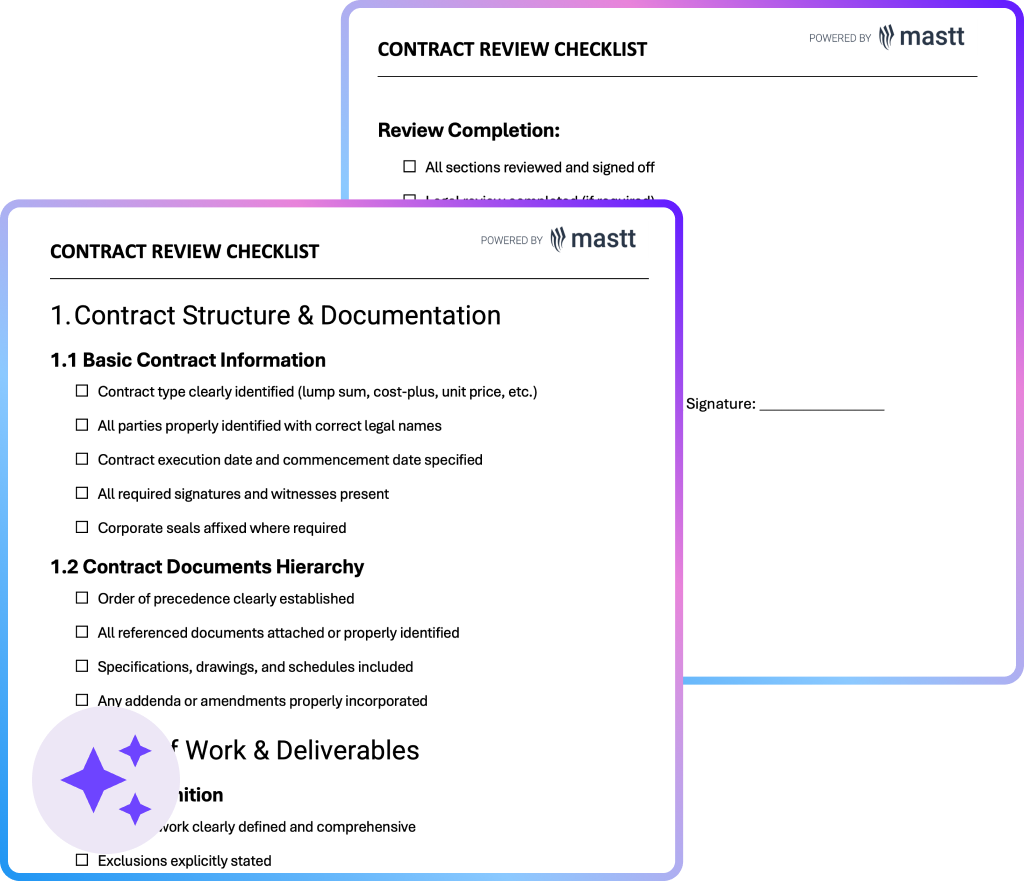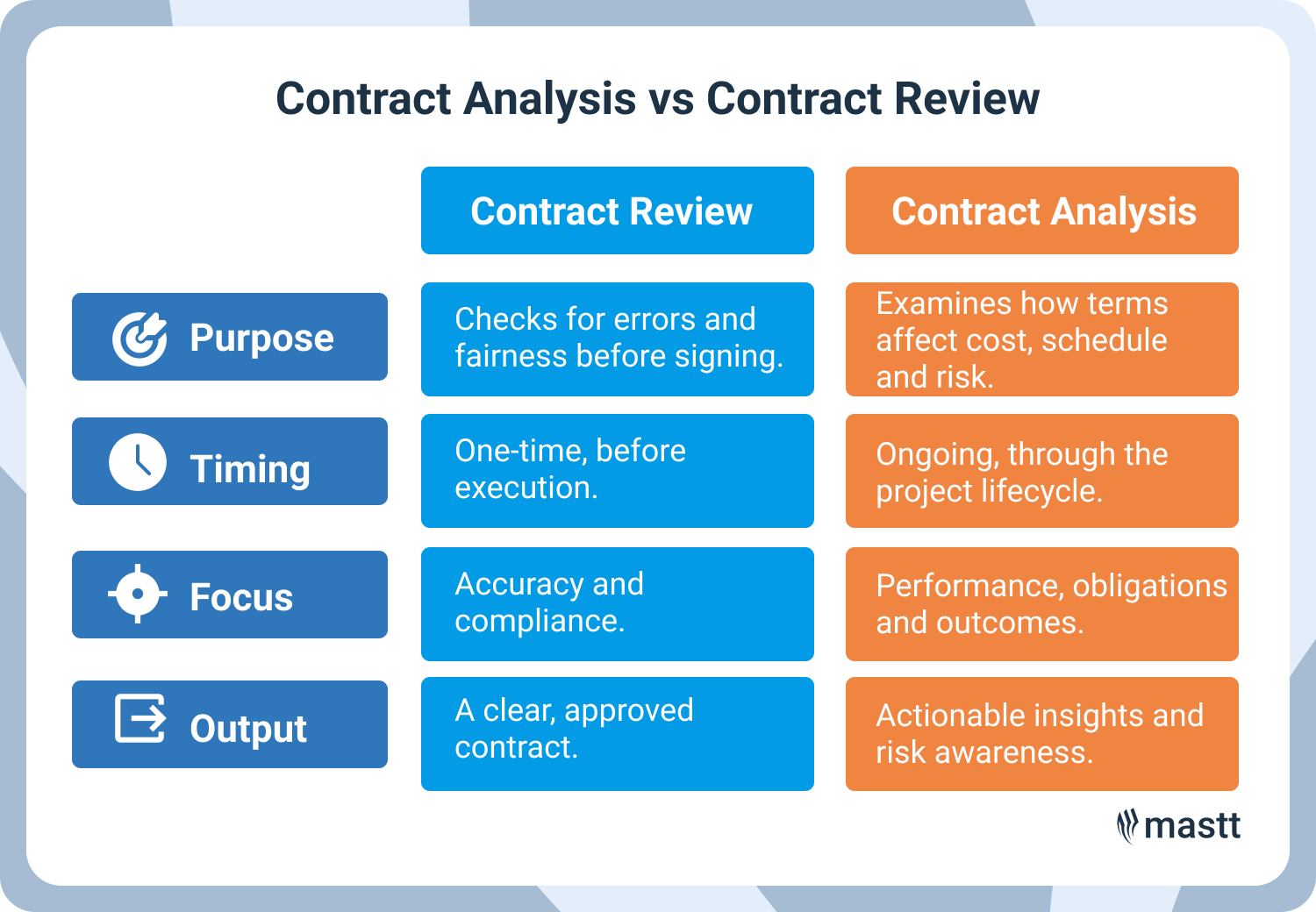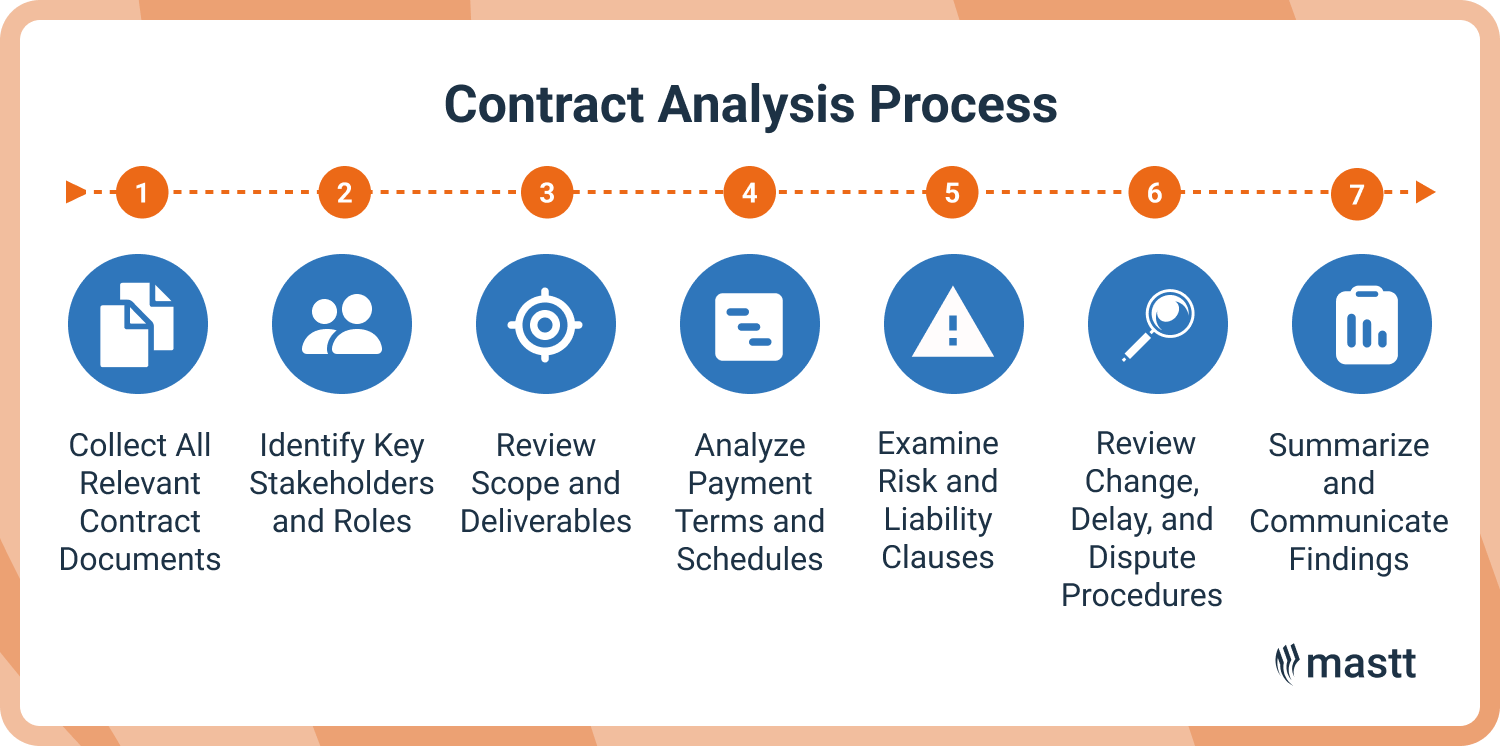Contract analysis in construction helps you manage risk, cost, and compliance. Learn simple steps and tools to keep your projects running smoothly.

Use this contract review checklist to review construction agreements with clarity. Track contract terms, obligations, risks, and compliance in one structured document before signing.

Contract analysis is the process of examining construction contracts to understand how each clause, obligation, and cost affects project success. More than a legal exercise, contract analysis is a project control tool, too. It connects what’s written in the contract to what happens on site.
In this guide, you’ll learn what contract analysis is, how it works, the key challenges to avoid, and the best tools and practices to do it effectively.
Contract analysis in construction is the detailed process of examining a contract’s terms, clauses, and obligations to understand how they affect project delivery. It involves examining construction clauses, obligations, and performance requirements to make sure all parties follow what’s been agreed.
Unlike a quick contract review, which happens before signing, contract analysis continues throughout the project life cycle. Contracts aren’t static. They evolve through amendments, addenda, and field changes. Continuous analysis helps project teams identify risks early, monitor compliance, and make data-driven decisions as work progresses.
A contract review is a one-time check before signing to confirm accuracy, completeness, and fairness. On the other hand, contract analysis is an ongoing process that tracks how clauses, risks, and performance requirements actually affect cost, schedule, and compliance once the project begins.

In short, a review asks, “Is this contract correct?” while analysis asks, “How will this contract perform during the project?” Many project teams stop at review and miss insights that continuous analysis provides, like identifying recurring disputes in change orders or delays caused by unclear payment terms.
Contract analysis helps project managers and owners gain visibility into how construction contracts drive cost, performance, and compliance. It provides the data and context needed to manage risk, forecast expenses, and keep teams aligned throughout the project lifecycle.
Here’s what effective contract analysis can do for construction projects:
Contract analysis turns paperwork into a project control tool by helping teams stay proactive instead of reactive. Regular reviews keep project data current, making it easier to catch compliance gaps, track costs, and manage risk before they grow into bigger problems.
Contract analysis is usually handled by the project manager or contract administrator, often with input from legal and commercial teams. Each team member contributes a different perspective that helps uncover risks, clarify terms, and ensure compliance from start to finish.
Here are the main roles typically involved in contract analysis and how they contribute:
💡Pro Tip: Build a cross-functional review routine early in the project. Have your PM, contract administrator, and legal team review contracts together before major milestones. This shared review catches issues that siloed teams often miss and keeps everyone aligned on the project’s commercial reality.
The process of analyzing a contract starts with understanding how each clause, obligation, and risk affects project delivery. While the steps may vary depending on the contract type or project size, most construction teams follow a clear, structured process designed to manage risk, confirm responsibilities, and keep projects running smoothly.
Start by gathering every related document: the main contract, appendices, specifications, drawings, and correspondence. This ensures you’re not reviewing the contract in isolation. Missing attachments or referenced schedules can create blind spots that lead to disputes later.
Clarify who is responsible for what. Understand the obligations of the owner, contractor, subcontractors, consultants, and suppliers. Documenting these responsibilities early helps prevent confusion once the project starts and ensures accountability.
Go through the scope of work line by line. Confirm that deliverables, project milestones, and acceptance criteria are clearly defined. In construction, scope gaps or overlaps are among the most common causes of change orders and cost overruns.
Check how and when payments are released. Review progress payment procedures, retention percentages, and claim submission deadlines. Payment timing directly affects cash flow, so this step protects both compliance and financial health.
Look closely at indemnities, warranties, limitations of liability, and force majeure provisions. Identify which party bears which risk. Understanding these clauses helps project managers plan contingencies and insurance coverage correctly.
Pay attention to clauses covering change orders, extensions of time, and dispute resolution. These dictate how changes are handled and how quickly conflicts can be resolved without escalation.
Compile a summary that highlights high-risk clauses, key obligations, and important deadlines. Share this with project teams and decision-makers. The goal is to translate complex contract language into key information for daily project management.
A thorough contract analysis should feel practical, not bureaucratic. The process is most effective when reviewed collaboratively between project managers, legal teams, and contract administrators.
💡Pro Tip: Link your contract analysis process directly to project performance metrics. Track how contract risks, payment terms, or scope changes affect cost and schedule outcomes across multiple projects. Over time, this data builds a feedback loop that strengthens negotiation strategy and reduces recurring contract issues.

Contract analysis can quickly become overwhelming as projects scale. Teams must manage hundreds of contracts, each with unique clauses, amendments, and compliance requirements. The difficulty lies in staying organized and accurate as the workload grows.
Here are some challenges that make contract analysis complicated for construction teams:
⚠️ Volume of Contracts: Large projects generate hundreds of agreements with owners, subs, and vendors. Finding one clause in a stack of multi-page documents can feel impossible without proper systems in place.
⚠️ Complexity of Language: Contracts are filled with technical and legal terms that must reflect current laws and project details. Outdated or vague language often leads to misinterpretation and disputes.
⚠️ Inconsistencies and Ambiguities: Duplicate terms, contradictory clauses, and unclear wording cause confusion and weaken enforcement. Even experienced teams can overlook these issues.
⚠️ Poor Data Integration: Contract information often sits in separate systems for accounting, project management, and procurement. This disconnect makes it harder to track performance and verify compliance in real time.
These challenges show why contract analysis needs both structure and technology. So, it’s essential to use an integrated contract management system to centralize data, reduce duplication, and keep every contract version accessible and consistent.
Contract analysis adds real value only when it’s consistent, detailed, and tied to daily project decisions. Many construction teams lose that value by treating analysis as a one-time task instead of an ongoing control process.
Here are common mistakes when analyzing a contract and best practices to avoid them:
Effective contract analysis depends on consistency and attention to detail. So, after each project, review your contract data and outcomes, then use those insights to refine templates and improve negotiation terms for the next job.
A good contract analysis workflow keeps projects compliant, organized, and free of surprises. The goal is to create a system that fits your project’s size, contract type, and reporting needs, not a one-size-fits-all checklist.
Step 1: Assign Clear Roles and Responsibilities
Start by defining who owns each part of the process. The project manager oversees timelines and deliverables, the contract manager tracks terms and compliance, and the legal or commercial team reviews risks and liabilities.
Everyone should know what to look for and when to escalate issues. Clear accountability prevents overlap and missed obligations.
Step 2: Map the Contract Lifecycle
Lay out the full timeline, from drafting to contract closeout. Identify key checkpoints such as award, notice to proceed, mid-project reviews, and completion. At each stage, specify what must be analyzed (e.g., payment terms, change orders, or performance milestones) and who’s responsible for approval.
Step 3: Centralize and Digitize Contracts
Use a shared digital platform to store all existing contracts, amendments, and correspondence. Centralization improves visibility, reduces version errors, and helps teams work from the same data.
Tools like AI construction contract review software automate this process by extracting key clauses, flagging risks, and summarizing critical obligations, saving hours of manual review while keeping records audit-ready.
Step 4: Automate Tracking and Reporting
Set up alerts for key dates like payment milestones, renewal deadlines, or insurance expirations. Use dashboards to visualize compliance and performance metrics. Automation ensures critical obligations never fall through the cracks and gives management real-time insight into project health.
Step 5: Review, Learn, and Improve
After each project phase, review what worked and what didn’t. Update your templates, checklists, and workflows to address recurring issues. This continuous improvement keeps your system relevant and builds institutional knowledge that strengthens future projects.
Technology now plays a central role in how construction teams analyze and manage contracts. The right tools help project managers and owners save time, reduce risk, and make more confident decisions by automating what used to take hours of manual review.
AI tools such as Mastt’s AI Contract Review use natural language processing (NLP) to scan, interpret, and summarize contracts in minutes. They flag risky or unusual clauses, highlight missing terms, and group obligations by category, like payment, insurance, or delay provisions.
This use of artificial intelligence in contract analysis gives teams a fast, consistent way to understand what’s in every contract without needing a full legal review. For busy construction managers, that means fewer surprises, faster approvals, and better risk visibility.
A contract management system serves as your project’s single source of truth. It organizes every contract, amendment, and correspondence in one secure location with full version control.
Features like searchable databases, automatic reminders for renewals or milestones, and built-in audit trails make compliance checks far easier. When all stakeholders work from the same data, it eliminates confusion and rework.
Modern tools convert dense contract data into visual dashboards. They show key insights such as payment progress, upcoming deliverables, and risk exposure in real time.
These data extraction tools help owners and project teams see patterns and make changes that improve future performance. Some platforms even allow users to compare multiple contracts to identify inconsistencies or outliers.
Integrated tools bring contract data and project management together in one workflow. Platforms like Mastt connect directly with the systems you already use, syncing financials, schedules, and contract terms in real time.
For example, when a change order affects payment terms, the update automatically appears in your project budget and reporting dashboards, no manual data entry required.
💡Pro Tip: Technology simplifies every part of the contract analysis process. If you’re starting to automate contract reviews, begin with Mastt’s AI Contract Review. It’s designed for construction teams and can instantly flag risks, summarize key clauses, and help you manage contracts more confidently across all your projects.
A strong project starts with clear, well-understood contracts. When teams understand every clause and responsibility, they manage risk, cost, and communication with confidence. Contract analysis gives them the insight to stay ahead of issues, make better decisions, and deliver projects with fewer surprises.

Cut the stress of showing up unprepared
Start for FreeTrusted by the bold, the brave, and the brilliant to deliver the future